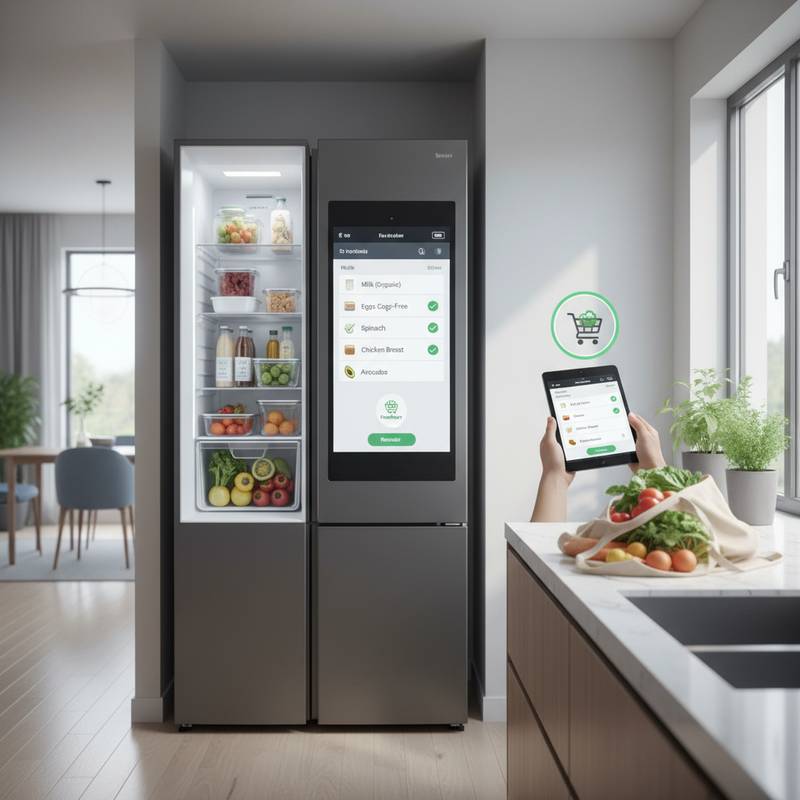Smart Fridges Outperform Meal Kits Through Automatic Ordering
Picture returning home after a demanding day to discover your refrigerator stocked with fresh ingredients for dinner. No hurried trips to the store, no overlooked items, and no spoiled produce tucked away. This scenario represents the everyday experience provided by advanced smart refrigerators equipped with automatic grocery ordering capabilities.
Understanding the Intelligence Behind Smart Refrigerators
Meal kit services initially provided appealing convenience through pre-portioned ingredients and guided recipes delivered directly to homes. However, recurring fees accumulate quickly, and excessive packaging contributes to environmental concerns. Smart refrigerators achieve similar benefits without mandatory subscriptions, allowing greater personalization in food choices and spending.
These appliances employ internal cameras, barcode readers, and artificial intelligence for precise inventory monitoring. As stock levels decrease, the refrigerator initiates orders via integrated grocery platforms. Users select preferred retailers, delivery schedules, and spending limits, while the device handles subsequent operations seamlessly.
Enhancing Daily Food Management with Automation
Automation forms the core benefit of these systems. Individuals avoid the need to track every basic item or monitor expiration dates manually. The refrigerator assumes responsibility for these tasks. Many units integrate with mobile devices, enabling remote inventory checks without accessing the appliance physically. Certain models generate recipe ideas based on available contents.
Consider these notable examples:
- Entry-Level Model: LG Smart InstaView LSXC22396S (approximately $1,499)
- Equipped with dual internal cameras for smartphone-based interior views.
- Compatible with Amazon Alexa and Google Assistant for voice commands.
- Provides notifications for depleting essentials such as milk or eggs.
- Intermediate Option: Samsung Family Hub RF27T5501SR (approximately $2,399)
- Supports direct ordering through Amazon Fresh integration.
- Includes a built-in touchscreen for organizing meals and accessing entertainment.
- Monitors expiration dates and recommends recipes via the SmartThings Cooking platform.
- High-End Choice: GE Profile Smart Refrigerator with Autofill and AI Vision (approximately $3,799)
- Employs visual identification technology to categorize food items automatically.
- Connects to Instacart for streamlined reordering.
- Incorporates energy optimization features and precise temperature controls for different zones.
These refrigerators link into broader smart home networks, facilitating unified control of shopping, cooking, and power usage through a single application.
Key Benefits Compared to Meal Kit Services
While meal kits streamline preparation, they impose restrictions on meal selections and serving amounts. Smart refrigerators promote adaptability by accommodating preferred foods, enabling orders at optimal times, and minimizing spoilage. Deliveries arrive without surplus packaging or cooling materials, sourcing items precisely from chosen local providers.
Appliance experts recommend selecting models with dual-band Wi-Fi for reliable auto-ordering performance. Earlier versions often encountered issues with 2.4 GHz connections, resulting in delayed notifications or incomplete lists. Review technical specifications for dual-band support to ensure long-term dependability.
Establishing Effective Auto-Ordering Systems
Implementation requires minimal effort. Begin by securing a Wi-Fi connection through the manufacturer's application, adhering to guided instructions for account linkage. Next, enable preferred grocery providers like Amazon Fresh, Walmart Grocery, or Instacart.
Adjust settings for order quantities to trigger reorders only when necessary. Although automatic approvals streamline the process, initial manual reviews build confidence in the system's accuracy. Integrate voice assistants such as Alexa or Google Assistant to facilitate additions like requesting yogurt for the list.
Completion of setup generally spans thirty minutes. Afterward, inventory access becomes available remotely, including during in-store visits for verification.
Essential Factors in Purchasing Decisions
These appliances qualify as significant investments, with prices ranging from $1,200 for basic units to over $4,000 for advanced configurations. Professional installation may incur additional fees of $100 to $200.
Prioritize Energy Star-rated models for efficiency. Such units involve a modest initial premium yet yield annual savings of $50 to $70 on electricity relative to conventional refrigerators.
Household size influences capacity needs; a 25-cubic-foot interior accommodates typical families, whereas 28 cubic feet or larger suits expanded groups. Confirm Wi-Fi signal strength in the kitchen area, as interruptions can disrupt ordering functions. Wi-Fi extenders serve as a practical solution if coverage proves inadequate.
An additional integration possibility involves home solar systems. Compatible refrigerators adjust operations like defrosting to align with high solar output periods, further lowering energy expenses through smart metering.
Maintenance and Security Practices
At their foundation, these remain standard refrigerators requiring routine care. Clean condenser coils periodically and replace air filters as recommended. Disconnect power prior to servicing internal sensors or cameras. For units with water dispensers or ice makers, change filters every six months to inhibit bacterial growth.
Regular software updates enhance camera precision and ordering dependability. Configure devices for automatic installations to capture all enhancements without oversight.
Integrating Smart Features into Your Routine
Smart refrigerators align with diverse lifestyles by reducing shopping demands and enhancing organization. Technology now integrates smoothly, appearing intuitive rather than experimental.
Introduce features gradually, starting with inventory monitoring or recipe generation. Progress to auto-ordering select staples like milk, eggs, or vegetables. Over time, such systems decrease unexpected shortages and promote sustainable habits.
Professional assistance eases initial setup for those preferring guidance. Certified technicians ensure optimal configuration for connected appliances.
Transform your kitchen into an efficient hub where preservation, accessibility, and innovation converge to support healthier, more streamlined living.
Frequently Asked Questions
What distinguishes smart refrigerators from traditional models?
Smart versions incorporate sensors, cameras, and connectivity for automated tasks like inventory tracking and ordering, beyond basic cooling functions.
Do auto-ordering features require a subscription?
No, these operate through one-time setup with grocery services, avoiding ongoing fees associated with meal kits.
How accurate is the inventory tracking?
Modern AI achieves high precision, though initial calibration and occasional manual adjustments improve reliability for unique items.
Are smart refrigerators energy-efficient?
Yes, Energy Star models reduce consumption by optimizing cycles, often saving $50 to $70 annually compared to non-certified units.
Can I integrate a smart fridge with other home devices?
Most connect via apps like Alexa or Google Home, enabling voice control and synchronization with lights, thermostats, and more.
